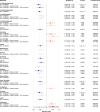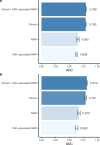Urinary metabolomics provide insights into coronary artery disease in individuals with type 1 diabetes
- PMID: 39593124
- PMCID: PMC11590341
- DOI: 10.1186/s12933-024-02512-8
Urinary metabolomics provide insights into coronary artery disease in individuals with type 1 diabetes
Abstract
Background: Type 1 diabetes increases the risk of coronary artery disease (CAD). High-throughput metabolomics may be utilized to identify metabolites associated with disease, thus, providing insight into disease pathophysiology, and serving as predictive markers in clinical practice. Urine is less tightly regulated than blood, and therefore, may enable earlier discovery of disease-associated markers. We studied urine metabolomics in relation to incident CAD in individuals with type 1 diabetes.
Methods: We prospectively studied CAD in 2501 adults with type 1 diabetes from the Finnish Diabetic Nephropathy Study. 209 participants experienced incident CAD within the 10-year follow-up. We analyzed the baseline urine samples with a high-throughput targeted urine metabolomics platform, which yielded 54 metabolites. With the data, we performed metabolome-wide survival analyses, correlation network analyses, and metabolomic state profiling for prediction of incident CAD.
Results: Urinary 3-hydroxyisobutyrate was associated with decreased 10-year incident CAD, which according to the network analysis, likely reflects younger age and improved kidney function. Urinary xanthosine was associated with 10-year incident CAD. In the network analysis, xanthosine correlated with baseline urinary allantoin, which is a marker of oxidative stress. In addition, urinary trans-aconitate and 4-deoxythreonate were associated with decreased 5-year incident CAD. Metabolomic state profiling supported the usage of CAD-associated urinary metabolites to improve prediction accuracy, especially during shorter follow-up. Furthermore, urinary trans-aconitate and 4-deoxythreonate were associated with decreased 5-year incident CAD. The network analysis further suggested glomerular filtration rate to influence the urinary metabolome differently between individuals with and without future CAD.
Conclusions: We have performed the first high-throughput urinary metabolomics analysis on CAD in individuals with type 1 diabetes and found xanthosine, 3-hydroxyisobutyrate, trans-aconitate, and 4-deoxythreonate to be associated with incident CAD. In addition, metabolomic state profiling improved prediction of incident CAD.
Keywords: Cardiac complication; Coronary artery disease; Machine learning; Metabolomics; Network analysis; Oxidative stress; Survival modeling; Type 1 diabetes; Urine.
© 2024. The Author(s).
Conflict of interest statement
Declarations. Ethics approval and consent to participate: The study was approved by the Ethics Committee of the Helsinki and Uusimaa Hospital District (491/E5/2006, 238/13/03/00/2015, HUS-3313-2018), and performed in accordance with the Declaration of Helsinki, with written informed consent obtained from the participants. Consent for publication: Not applicable. Competing interests: S.M. received a lecture honorarium from Encore Medical Education. P.-H.G. has received investigator-initiated research grants from Eli Lilly and Roche, is an advisory board member for AbbVie, Astellas, AstraZeneca, Bayer, Boehringer Ingelheim, Cebix, Eli Lilly, Janssen, Medscape, Merck Sharp & Dohme, Mundipharma, Nestlé, Novartis, Novo Nordisk and Sanofi; and has received lecture fees from Astellas, AstraZeneca, Bayer, Boehringer Ingelheim, Eli Lilly, Elo Water, Genzyme, Merck Sharp & Dohme, Medscape, Novartis, Novo Nordisk, PeerVoice and Sanofi.
Figures







References
-
- Jansson Sigfrids F, Groop P-H, Harjutsalo V. Incidence rate patterns, cumulative incidence, and time trends for moderate and severe albuminuria in individuals diagnosed with type 1 diabetes aged 0–14 years: a population-based retrospective cohort study. Lancet Diabetes Endocrinol. 2022;10:489–98. - PubMed
-
- Harjutsalo V, Pongrac Barlovic D, Groop P-H. Long-term population-based trends in the incidence of cardiovascular disease in individuals with type 1 diabetes from Finland: a retrospective, nationwide, cohort study. Lancet Diabetes Endocrinol. 2021;9:575–85. - PubMed
-
- Stanescu DE, Lord K, Lipman TH. The epidemiology of type 1 diabetes in children. Endocrinol Metab Clin. 2012;41:679–94. - PubMed
Publication types
MeSH terms
Substances
LinkOut - more resources
Full Text Sources
Medical
Miscellaneous

